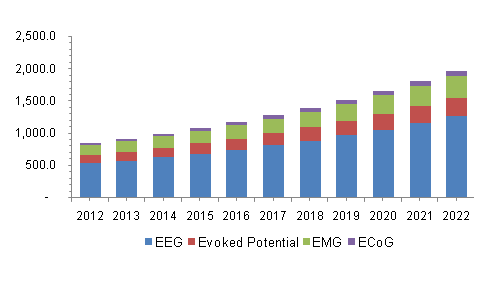
Nerve Monitoring Devices Market Analysis By Products (Monitors, Electrodes, Ancillary Products), By Technology (EEG, Evoked Potential, EMG, ECoG) And Segment Forecasts To 2022
- Report ID: 978-1-68038-695-0
- Number of Pages: 84
- Format: Electronic (PDF)
- Historical Data: 2013-2015
- Industry:Healthcare
Industry Insights
The global nerve monitoring devices market size was valued at USD 1,001.4 million in 2014 and is expected to grow at a CAGR of 8.9% over the forecast period. Rising prevalence of neurological diseases is anticipated to be the highest impact rendering driver for the industry
According to the statistics published by the World Health Organization (WHO), approximately 50 million people worldwide suffer from epilepsy making it most common neurological disorder globally.
North America nerve monitoring device market, by technology, 2012-2022 (USD Million)

The population is aging rapidly, and as per the WHO statistics, the proportion of world’s population is expected to nearly double from 12.0% to 22.0% between 2015 and 2050. Aging is considered as one of the prime risk factors for the neurological disorder. Approximately, 20% adults aged 60 and above are suffering from neurological conditions and over 6.6% disabilities in geriatric population are attributed to neurological disorders. Rapidly growing geriatric population is expected to be the vital driver for the growth of the nerve monitoring device market.
The advent of technologically advanced products such as wearable device is projected to exhibit substantial growth in this industry. Advantages offered by the wearable devices such as increased mobility and round-the-clock monitoring are expected to further drive market growth.
Technology Insights
Key technologies analyzed in this study include Electroencephalography (EEG), Electromyography (EMG), evoked potential, and Electrocorticography (ECoG). Evoked potential consists of Somatosensory Evoked Potentials (SSEP), Transcranial Electrical Motor Evoked Potentials (TCeMEP), Brainstem Auditory Evoked Potentials (BAEP), and Visual Evoked Potentials (VEP).
Electroencephalography dominated the technology segment with approximately 65.0% share and it is anticipated to witness lucrative growth over the forecast period. This can be attributed to its wide clinical applications in neurological diseases. Moreover, this modality can unfold the brain activity in real-time in milliseconds, thus offering higher accuracy.
On the other hand, electromyography is also expected to witness substantial growth in the next seven years owing to rising prevalence of neuromuscular diseases such as muscular dystrophies and muscle rheumatism. Moreover, electromyography has higher accuracy over magnetic imaging such as Magnetic Resonance Imaging (MRI). These factors are anticipated to drive the growth of EMG over the forecast period.
Products Insights
On the basis of product, the market is divided into monitors, electrodes, and ancillary products. Monitors dominated the product segment with over 75.0% share owing to their high prices coupled with increased demand.
On the contrary, ancillary products such as disposable sponge disks, abrasive gel, alcohol swabs, disposable filter, and electrode creams are expected to witness lucrative growth over the forecast period. This can be attributed to increased usage of nerve monitoring systems and repeat purchase of these accessories.
Regional Insights
Geographically, the market is divided into North America, Europe, Asia-Pacific, Latin America, and the Middle East & Africa. North America dominated this industry with over 45.0% share in 2014 due to its advanced healthcare system. Moreover, availability of favorable reimbursement coupled with rising disposable income is facilitating early and preventive diagnosis, thereby increasing the demand for nerve monitoring devices.
Asia Pacific is expected to register the fastest growth rate during the forecast period. The presence of large untapped opportunities in emerging economies such as India and China is anticipated to exhibit growth of this industry. In addition, improving healthcare infrastructure coupled with supportive government initiatives is anticipated to accentuate growth of the nerve monitoring device market.
Competitive Market Share Insights
Key players operating in this market include Medtronic Plc., NuVasive, Inc., Nihon Kohden, Natus Medical Inc., Langer Medical GmbH, Neurosign Surgical, Neurowave Systems, Cadwell Laboratories, Compumedics Limited, and Electrical Geodesics Inc. The key trends witnessed in this market include new product launches, technological advancements, and collaborations to gain competitive advantage.
For instance, in January 2015, Natus Medical Inc. announced its entry in neurodiagnostics market through the acquisition of Global Neuro-Diagnostics, a provider of home-based EEG testing. This acquisition helped the company to widen the portfolio of neuromonitoring offerings.
Furthermore, in January 2013, Natus Medical Inc. acquired Grass Technologies Product Group from Astro-Med, which included product portfolio for neurodiagnostics and monitoring products. This acquisition helped the company to strengthen its portfolio of EEG systems.
分析的角度
The scope of study encompasses key products and technologies. Attributes are represented in platforms which would provide insights to manufacturers, distributors, investment bankers and new entrants. Estimates and forecasts are based on triangulation of information acquired or analyzed using more than three approaches or models.
Commodity flow approach involving demand estimation and movement of a product from the manufacturer to the end-use segments were analyzed in an attempt to formulate base estimates. Variable analyzes based on QFD models were implemented in order to forecast growth. More than 100 primary respondents have been contacted and their perspective accounted for.
市场涉及神经监测装置是very dynamic and involves extensive R&D initiatives. The study focuses on a wide scope and includes representation on most technology and product types. Regional scope, however, is kept limited in an attempt to ensure study proportions. Customization on any segment of this study will be available upon request.





